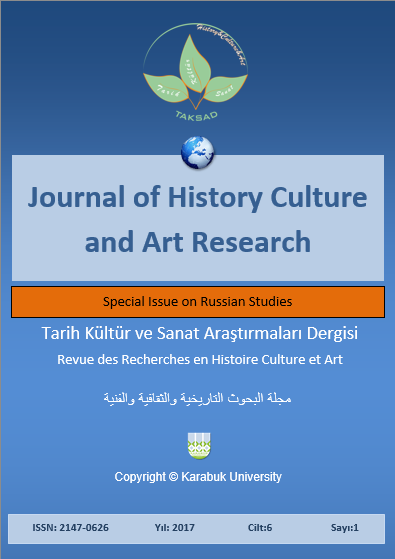Conceptualization of Optimistic Models for the World in Paremic Picture of the World
DOI:
https://doi.org/10.7596/taksad.v6i5.1287Keywords:
Paremia, Paremic picture of the world, Discourse-and-model concept, Paremic frame, Paremic value.Abstract
The description of language expression of an ethno cultural stereotype in assessment of optimistic approach to judgment of a role of trials destiny provides in human life is offered. The optimistic outlook model is considered as integrative linguo-cognitive area which valuable dominants are directly connected with points, key for national sphere of concepts. The algorithm of a descriptive technique is presented on the example of cognitive and pragmatical modeling of semantics in the Russian proverbs of theme groups "Destiny - Patience - Hope" and "Patience - Hope" from the collection "Proverbs of the Russian People" of V. I. Dahl. The area of paremic verbalization of cognitive category "Optimism" is considered taking into account polyconceptuality of national aphorisms maintenance and ambivalence of the ethno culture major stereotypes assessment concluded in them. Linguo-cognitive potential of paremias in representation of optimistic outlook model is defined with aphoristic value of paremias, pragmatical recommendation expressed in them and a valuable semantic core.
References
Alefirenko, N. F. (2003). Sense, modus concepts and value. Bulletin of the Chelyabinsk state university, Philology, Art criticism, 84(31), 8-14.
Barsalou, L. W. (1992). Frames, concepts and conceptual fields. In A. Lehrer & E.V. Kittay (eds.). Frames, fields and contrasts: New essays in semantic and lexical organization, (pp. 21-73). Hillsdale, NJ: Lawrence Erlbaum associates.
Bennett, O. (2011). Cultures of optimisms. Cultural Sociology, 5(2), 301-320.
Distance, V. I. (2005). Proverbs of the Russian people. Eksmo, NNN.
Fauconnier, G. (1994). Mental Spaces: Aspects of meaning construction in natural language. Cambridge: Cambridge University Press.
Flick, U. (1994). Social representations and social constructions of everyday knowledge: Theoretical and methodological queries. Social Science Information, 33, 179-197.
Kluckhon, F. & Strodbeck, F. (1961). Variation in Value Orientations. Peterson & Co.
Kovshova, M. L. (2016). A linguoculturological method in phraseology. LENAND.
Loemker, L. E. (1996). Pessimism and optimism. In P. Edwards (ed.). The Encyclopedia of Philosophy. New York: Simon and Schuster MacMillan.
Propp, V. Ya. (1999). Problems of comedy and laughter. Ritual laughter in folklore. Labyrinth.
Rosch, E. (1978). Principles of categorizations. In E. Rosch & B.B. Lloyd (eds.). Cognition and categorization, (pp. 27-48). Hillsdale, NJ: Lawrence Erlbaum associates publishers.
Schiffer, S. R. (1972). Meaning. Oxford: Oxford University Press.
Semenenko, N. N. (2015). Discourse factor of valuable parametrization of paremias. Topical issues of modern science, 2(5), 174-179.
Shulyatikov, I. S. (2015). The term "concept" in modern linguistics. Bulletin of the Vyatka state humanities university, 12, 98-102.
Timothy, C. P. (2007). Structures and categories for the representation of meaning. Cambridge University Press.
Downloads
Published
How to Cite
Issue
Section
License
All papers licensed under Creative Commons 4.0 CC-BY.- Share — copy and redistribute the material in any medium or format
- Adapt — remix, transform, and build upon the material for any purpose, even commercially.
Under the following terms:
Attribution — You must give appropriate credit, provide a link to the license, and indicate if changes were made. You may do so in any reasonable manner, but not in any way that suggests the licensor endorses you or your use.
- No additional restrictions — You may not apply legal terms or technological measures that legally restrict others from doing anything the license permits.







